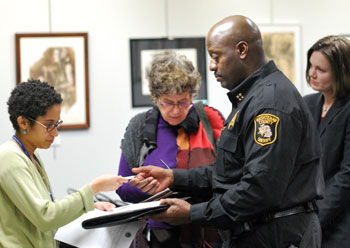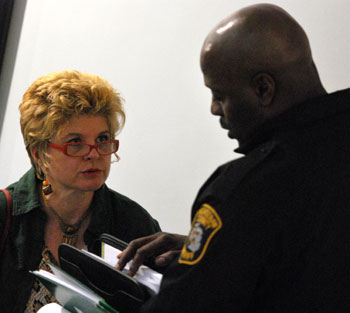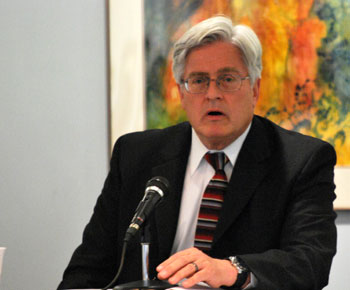Panel Sheds Light on Washtenaw Jail

Release forms for a video of Thursday's panel are collected from panelists by Shannon Riffe of the Ann Arbor District Library, far left. Standing left to right are county commissioner Barbara Levin Bergman, Washtenaw County sheriff Jerry Clayton, and Christine Negendank, of the county's Community Support and Treatment Services. Not in this photo, but also on the panel, was Washtenaw County prosecutor Brian Mackie. (Photo by the writer.)
During Thursday night’s panel discussion on the Washtenaw County jail, one message from sheriff Jerry Clayton was this: It’s his job to administer the jail, but it’s the whole county’s jail – it’s our jail.
Clayton was joined on the panel by Washtenaw County prosecutor Brian Mackie, Washtenaw County commissioner Barbara Levin Bergman, and Christine Negendank, a psychiatrist with the county’s Community Support and Treatment Services department. The event was hosted by the League of Women Voters at the downtown Ann Arbor District Library.
The format allowed some time for audience members to have their written questions put to the panelists. Among those questions were concerns about translation services at the jail for non-English speaking inmates and possible racial profiling of Latinos in the immigrant population.
Questions posed by the League of Women Voters provided panelists a chance to give somewhat of a tutorial on how the government’s system of punishment works – Brian Mackie was asked to start with an explanation of the difference between jail and prison.
Jail Versus Prison
One key difference between jail and prison, explained Mackie, is that jails in Michigan are county-operated, whereas prisons are state-operated facilities. So the Washtenaw County jail is a place where (i) suspects are detained short-term after arrest but before they’re arraigned, (ii) defendants are held who haven’t been released on bond – who are accused of either felonies or misdemeanors, and (iii) people convicted of either felonies or misdemeanors serve their sentences.
After a suspect is arrested, Mackie said, it’s always possible to get arraignment and charging completed within 24-hours because there’s a judge and a prosecutor on duty every day of the year.
The maximum sentence to a county jail in Michigan, clarified Mackie, is one year. That’s important to bear in mind, he said, when comparing prison commitment rates across different states. Pennsylvania, for example, allows jail sentences for up to five years – so lower statistics for Pennsylvania prisons could reflect higher numbers in jails.
In Michigan, 49% of convicted felons are sentenced to time in local jails, Mackie reported, while the national average is 30% – that reflects an unfunded mandate from the state to deal with convicted felons at the community level, he contended.
The 332-bed Washtenaw County jail is the smallest jail per capita in Michigan, Mackie said. [The new jail expansion would increase the number of beds by 112 to 444.] In recent years, the prison commitment rate in Washtenaw County had crept up from the second lowest in the state at around 16% to where it’s now around the state average in the low 20s, Mackie said. Asked whether he thought there was a connection between the jail capacity and that increase in prison commitment rate, Mackie said he had trouble not seeing the correlation.
How the Jail Works
Even though the jail expansion would add 112 beds – provided that funding for its operation can be found to bring it online in October or November of 2010 – Sheriff Clayton cautioned: “We will never have enough jail beds if we do not change the way we engage people in society.”
While the jail is ultimately his responsibility, Clayton said, it’s administered directly by a commander, three lieutenants, eight sergeants, and 84 corrections officers.
He also heaped praise on the number of volunteers who came into the jail to support various programs like classes in literacy and anger management.
The physical surroundings of the jail, Clayton said, are not what maintains safety. That is, it’s not the walls, the bars, and the windows that manage the inmates. Rather, it’s human engagement of inmates that should manage their behavior.
To engage inmates effectively, Clayton said, it’s important to know who they are: What risks do they pose and what needs do they have? Who are the people at the jail? Clayton gave a quick statistical snapshot.
In 2008, Clayton reported, 7,901 people came in and out of the Washtenaw County jail. In round numbers:
Male: 88% Female: 11% Misdemeanor: 56% Felony: 43% Mental Illness: 27% Substance Abuse: 75% Unemployed: 63% Homeless: 14-17% No h.s. diploma: 36%
-
Assessing risks and needs of the inmates on intake was the first of six points ticked off by Clayton as the jail’s mission. The others: (ii) assign appropriate housing, putting like groups together, (iii) meet basic needs – the need to feel safe, have shelter, food, and a connection with others, (iv) define expectations – the belief that inmates will conform to the rules and be productive, (v) engage inmates through human interaction, and (vi) keep inmates productively occupied.
Medical Services
While Christine Negendank focused her remarks primarily on the mental health side of medical services, a question from the audience also drew out the fact that the jail provides other medical services as well – a dentist as well as an OB/GYN for pregnant inmates. Commissioner Bergman pointed out that Medicaid does not cover medical treatment while incarcerated. The total cost to the county per year for inmate medical care runs about $1 million.

Christine Negendank, a psychiatrist with the county's Community Support and Treatment Services department. (Photo by the writer.)
Negandank described the Community Support and Treatment Services jail diversion program, which aims to provide alternatives to incarceration for those with mental illness. She also described JPORT (Justice Project Outreach Team), which works both inside and outside the jail after release to provide mental health services.
Negandank said that it’s possible for her to see an inmate in jail, know they’re getting out of jail, and tell them: “I’ll see you in two weeks at my office downtown.” She stressed that securing funding for mental health medications was a challenge, but that providing mental health services was more than just dispensing medications.
The challenge of supporting inmates released from jail again drew out the difference between jail and prison: There’s a longer planning time for eventual reintegration into society from prison – facilitated by organizations like the Michigan Prisoner ReEntry Initiative (MPRI). Given the shorter length of time spent at jail facilities, there’s less time to anticipate and plan for time after release.
One of the audience questions addressed the issue of the time of day inmates were released. Clayton clarified that yes, inmates were released at midnight – because if a release date was Nov. 12, say, then holding them until 6 a.m. on Nov. 12 would mean an extra six hours of incarceration to which they had not been sentenced.
Another audience question drew out Mackie’s view that the work of Dawn Farm (which has the in-jail substance abuse services contract) and other social-justice nonprofits like Community Action Network and Peace Neighborhood Center was crucial to reducing the burden on the criminal justice system.
Funding the Jail and Its Expansion
Barbara Levin Bergman drew the question from the League about how the jail was funded. She began saying that she was one of 11 county commissioners who allocated money to the justice system, of which the jail was a part.
She stressed that those allocations, whether they were to the prosecutor’s office or to the jail, were made as part of a budget management process that included communication between the board of commissioners and the departments to which they allocated money.
One of the audience questions specifically addressed the jail expansion of 112 beds: How would that be funded? Bergman, in her remarks made earlier in the evening, had said that she was one of the people who had voted to build the expansion, which broke ground in December 2008.
Even when the construction is completed, it’s not clear if the county will open the new facility. From The Chronicle’s previous coverage in May: “Targeted Cuts for Washtenaw County Budget“:
[County administrator Bob Guezel] also laid out a wide range of possible cuts, including selling county-owned facilities – he noted that the Zeeb Road building was only half occupied, for example – and even the possibility of not opening the jail expansion when it’s completed in 2010. That expansion, which would provide an additional 112 beds, would cost at least $1 million extra per year to staff. He said that though governments in general are good at finding one-time solutions, “what we need going forward is primarily structural savings.”
What the sheriff’s department budget will look like in the county’s budget also probably won’t be clear even after the county votes on the final budget for 2010/2011, which might come at the board’s next meeting. From The Chronicle’s coverage “County Board Set for First Budget Vote“:
One unresolved issue is the final budget for the sheriff’s department. At last week’s administrative briefing, Guenzel told commissioners that he and sheriff Jerry Clayton were still negotiating, and that they wouldn’t likely reach an agreement in time for the final budget approval. Guenzel plans to come to the board at a later date with a budget amendment that would address the results of their negotiations.
Though they were expected to make an initial vote at their Nov. 4 meeting on the final 2010/2011 budget, commissioners removed that item from their agenda. The next chance to vote on the budget – likely still without the sheriff’s department portion – will be Nov. 18.
At the League of Women Voters panel on Thursday, Clayton said that the question of whether there’d be enough money to open the jail expansion was still to be answered. The numbers were still under discussion, he said. But he emphasized that “I am sound on those numbers. We won’t bring numbers that are fluff.” Saying that while he didn’t mean to be flippant about it, the situation could be compared to the old Fram air filter commercial where the mechanic compares the cost of the air filter to the cost of engine replacement: “You can pay me now … or pay me later.”
Bergman described the discussion on providing funding to staff the new jail expansion as “tension among friends.”
Clayton stressed that the sheriff’s department was trying to do its part by becoming more efficient and raising revenues. That prompted Bergman to remark that the “frosting on the cake” to revenue generation was that his deputies were writing tickets in Ann Arbor. An audience question asked about billing inmates for the services they used, but Clayton seemed skeptical that it was an avenue worth pursuing aggressively – in light of the 63% unemployment rate among inmates.
Clayton described the jail expansion as a part of a “social justice campus” where there could be some level of supervision while inmates work at outside jobs but return for the night. They’d get supervision and support, plus treatment for substance abuse if needed, when they returned to campus each night.
In his remarks, Mackie also emphasized that it was important to distinguish between the tiny number of people who are “just purely evil” and those who needed some supervision that might not entail full-time incarceration. As an example, he gave a repeat drunk-driving offender, who might be treated in a cheaper, more humane way at something like a “probation residential center” than at a jail.
Clayton contrasted the feel of the jail expansion as fundamentally different from the old part of the jail. It was not constructed to be in any way luxurious, he said, but it did not communicate the expectation that inmates would act out. Rather, it communicated the idea that they were expected to behave appropriately.
Audience Questions: Immigrant Population
In addition to some of the audience questions already described, two related specifically to the immigrant population in Washtenaw County. What kind of support is there for non-English speaking inmates?

After the panel concluded, Laura Sanders of the Washtenaw Interfaith Coalition for Immigrant Rights pressed sheriff Jerry Clayton for some answers on treatment of the local immigrant population. (Photo by the writer.)
Clayton allowed that this was an area he’d noticed upon taking office a little under a year ago, saying that service for non-English speakers was “not where it should be.” As an example, he cited an orientation videotape that is shown to inmates – it’s in English only. The jail does employ translator services for inmates who don’t speak English.
A second question related to possible racial profiling of Latinos during traffic stops. The way Washtenaw County deals with racial profiling was actually a strength of the county, Mackie said. He pointed out that Clayton was a nationally-recognized expert on addressing racial profiling. ["Practitioners Guide For Addressing Racial Profiling" was co-authored by Clayton. Prior to his election, Clayton also ran a consulting firm specializing in dealing with racial profiling.]
Clayton said that in their training, they stressed that a traffic stop must be based purely on a suspect’s behavior, not anything else. In thinking about their own actions, officers should be able to answer the question: Why did you do this? Clayton said it was a dual education challenge: (i) educate officers about how to treat suspects, and (ii) educate citizens about why officers do what they do.
The author of the question about racial profiling had a somewhat more pointed question in mind. [Questions were written out and read by the League of Women Voters]. The question had come from Laura Sanders of the Washtenaw Interfaith Coalition for Immigrant Rights.
According to Sanders, a new requirement that a Social Security number be produced in order to obtain/renew a Michigan driver’s license has led to the following kind of scenario: (i) an immigrant cannot renew their license, (ii) when pulled over at a traffic stop, they can’t produce a current license, (iii) instead of receiving a ticket for driving on an expired license, they’re arrested and taken to the jail, (iv) immigration services are contacted and (v) deportation proceedings begin.
Sanders contends that if a driver were not a Latino, they’d simply be given a ticket, not arrested and taken to jail – that’s racial profiling, she says.







Every time I read what the Sheriff has said, I like him more and more. The thing I don’t like from Sanders is the assumption that all latino’s are immigrants and/or all immigrants are latino. Maybe I’m reading this wrong… but that’s how I read it. Also, legal immigrants can get social security numbers; so her statement should be that (i) an ILLEGAL immigrant cannot renew their license.
Thanks for your coverage of the jail–between this, the MPRI story, the jail diary and your general coverage of county finances, I feel like I’m getting more depth than I normally would. It would good to connect the dots, and hear, say, the Sheriff’s reaction to the jail diary.
I don’t believe the current Sheriff had been elected at the time of the piece.
That’s correct. I didn’t mean a “how could you!?” piece. But I’m assuming things aren’t radically different now.
I’m not overly concerned with language coverage for non-native speakers. Sorry. Don’t want my tax dollars going to that.